The Baltic Countries and the Western Balkans are two geopolitical areas with considerably different traditions, economies, and political environments. However, the rise of radical right-wing populist and far-right parties in both areas exposed several similarities concerning EU policies, immigration, national identity perceptions, and minority rights.
The latest book of Vassilis Petsinis, “Cross-Regional Ethnopolitics in Central and Eastern Europe: Lessons from the Western Balkans and the Baltic States (Central and Eastern European Perspectives on International Relations)” appeared in April 2022. It performs a comparative and cross-regional study on Latvia and Estonia, Croatia and Serbia.
European Interest had the opportunity to interview Vassilis Petsinis on the objectives of his study. The author addressed a broader range of topics about nationalism, identity-making, and gender politics, including LGBTQI rights.
Vassilis Petsinis is a Senior Researcher (Vanemteadur) in Comparative Politics at Johan Skytte Institute of Political Studies at the University of Tartu, Estonia. He has academic expertise in European Politics, Nationalism, Ethnic Relations, Populism, Euroscepticism, and Regionalism, with a focus on Central and Eastern Europe.
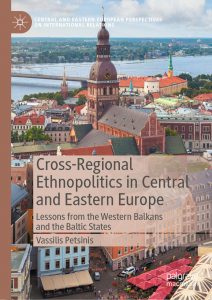
European Interest: Your latest book focuses on two geopolitical areas in Europe where nationalism, far-right parties and tendencies, and Euroscepticism still play a considerable role in national politics. The Western Balkans (Croatia and Serbia) and the Baltic States (Estonia and Latvia). Which was the motivation behind this comparative and cross-regional study?
Vassilis Petsinis: The primary objective was to contribute to inter-regional, intellectual, dialogue and relax the barriers that exist between political scientists and policymaking experts working on different parts of Europe (in this case, Southeast Europe and the Baltic States). From a purely academic angle, the cross-regional focus of my latest monograph tests the validity and, at the same time, updates and upgrades older theoretical approaches for the study of ethnopolitics. This endeavour acquires a greater significance when taking into consideration older empirical research in the former Yugoslavia and the Baltic States (1990s and 2000s) that has provided much of the material for the formulation of these theoretical models.
By comparing different post-Communist settings (two post-Yugoslav states: Croatia and Serbia; two post-Soviet states: Estonia and Latvia), this book provides new insights in conflict resolution and the management of ethnic relations in the new and the aspiring EU member-states (e.g. Serbia). The cross-country and cross-regional focus has a practical dimension, too: A comparative approach helps the reader assess the degree to which certain states can learn from the successes and/or shortcomings of others in the field of accommodating ethnic differences. This, in turn, will contribute new insights towards the elaboration of alternative models for understanding ethnopolitics drawn from the East European multi-ethnic experience. This is of great significance, considering that East European researchers have been mostly employing ‘Western’ theoretical models for the study of ethnopolitics in Central and Eastern Europe.
Radical populist and far-right parties are significant players in the Baltic States. Mainly the National Alliance in Latvia and the EKRE in Estonia. These parties participated in coalition governments with the Christian democratic party in Latvia and a liberal party in Estonia (2019-21). Which is their impact on national politics concerning the adoption of European values and defence matters?
Regarding Euroscepticism per se, both EKRE (Estonian Conservative People’s Party) and the NA (Latvian National Alliance) have been contesting the EU’s quotas arrangement for the redistribution of refugees from MENA (2016-up to date). Starting with EKRE, its Euroscepticism is tripartite and consists of the following components: socio-cultural (e.g. opposition to the EU’s guidelines on LGBTQI rights), ecological/environmental (mainly the party’s opposition to the EU-funded Rail Baltic project – which aspires to connect the Baltic States with Central Europe via railway), and geopolitical Euroscepticism. The brand of Euroscepticism espoused by the NA is predominantly geopolitical. The geopolitical Euroscepticism of both parties has long consisted in their mutual discontent over the EU’s cooperation with Russia in energy issues (the Nord Stream II pipeline, in particular). Moreover, both EKRE and the NA have been urging the EU to firmly align with NATO’s defence doctrine and harbour scepticism over ‘parallel’ structures such as the EU Security Union project.
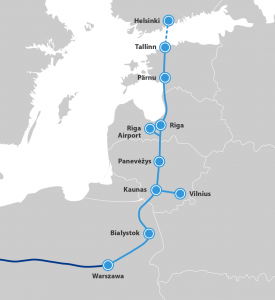 The Rail Baltica as Part of the North Sea-Baltic Core Network Corridor [CC BY-SA 4.0]
The Rail Baltica as Part of the North Sea-Baltic Core Network Corridor [CC BY-SA 4.0]
Overall, the two parties express their preference for a unipolar world order where a preponderant NATO protects Estonia and Latvia against any security threats emanating from Russia. In all of this, it should be taken into account that the Euroscepticism of the NA (both in terms of rhetoric and political practice) is considerably softer in comparison to that of EKRE. For instance, by contrast to EKRE, the NA does not acknowledge the right of EU member-states to leave the EU if they decide so (e.g. through a referendum).
In the South periphery of the EU, the Western Balkans, the far-right and populism are present in government politics, as in Serbia. Which are the main characteristics of this phenomenon? Which are the most threatening items that the area faces?
Since 2016, the ruling (nominally centre-right, conservative) Serbian Progressive Party/SNS has succeeded in dominating a continuum that stretches from the boundaries of the liberal centre all the way to the conservative right. Especially in regard to the public sector and state-run institutions, the party has proved successful in setting up a countrywide network entrenched in political clientelism. This network was systematically activated and mobilized, prior to the latest parliamentary elections (2020), via means of SMSs and telephone calls to SNS’ voters. In addition, SNS has long anchored its status as the most popular option among electoral segments such as pensioners – an observation which is of remarkable importance in a rapidly ageing society. By contrast, Serbia’s oldest far-right party (the Serbian Radical Party/SRS) and other smaller parties of the radical and more extremist right (e.g. Dveri, Srbska Akcija, Levijatan) are not represented in the national parliament. The main threat in Serbia should be sought in a potential attempt by the ruling SNS and President Aleksandar Vučić to take further advantage of their preponderance within the political spectrum and ‘hijack’ the state institutions.
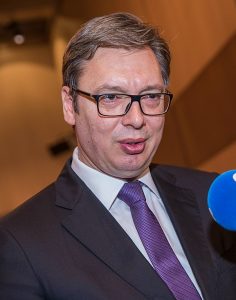 [President Aleksandar Vučić, CC BY 2.0]
[President Aleksandar Vučić, CC BY 2.0]
Meanwhile, in Croatia, the operation of a ‘right-wing faction’ within the ruling (nominally centre-right, conservative) Croatian Democratic Union/HDZ has enabled the party to win hearts and minds among the more nationalistic and socially conservative segments of the electorate – especially in regions such as Dalmatia and Slavonia. At the same time, the oldest and more extremist parties of the Croatian far right (the Croatian Party of Rights/HSP, the Croatian Pure Party of Rights/HČSP, and the Autochthonous Croatian Party of Rights/A-HSP) appear to be in a state of disarray with a feeble electoral appeal and a low mobilizing potential. However, since the parliamentary elections of 5 July 2020, the national conservative Homeland Movement/DP emerged as a formidable contender to the right of HDZ with the potential of additionally side-lining the more extremist right-wing parties. The DP shares quite a few policymaking principles with the ‘right-wing faction’ inside HDZ, especially in areas such as minority issues; LGBTQI rights, abortion, and other gender-related themes; relations between clergy and state; the management of the migration crisis; and the implementation of stricter ‘law and order’ agendas – coupled with the occasional communication of soft Eurosceptic standpoints. The participation of an invigorated DP to the right of HDZ poses a crucial challenge to the alleged endeavour by HDZ-chairman and Croatian PM Andrej Plenković to shift the official party-narrative more firmly towards the centre. This, in turn, is likely to readjust, to varying degrees, the intra-party equilibrium between the more liberal and the more conservative factions of HDZ.
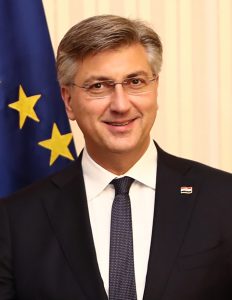 [Andrej Plenković, PM of Croatia and President of the HDZ, Attribution: Ministry of the Presidency. Government of Spain]
[Andrej Plenković, PM of Croatia and President of the HDZ, Attribution: Ministry of the Presidency. Government of Spain]
However, gender politics play a central role in far-right politics in both regions. In the case of the Baltics, where the far-right parties are openly anti-feminist, it is difficult to understand how these Nordic societies express support for discriminative arguments and politicians.
EKRE and the NA have been long regarding (ethnic and sexual) minority rights as ‘externally imposed’ by international organizations (e.g. the UN) and supranational entities (e.g. the EU and COE). Regarding LGBTQI rights, in particular, the landscape becomes fuzzier because, as in many other parts of Europe, this set of rights is additionally seen as being externally imposed by ‘agents of cultural Marxism’ and/or ‘the global gender ideology’.
The programmatic standpoints of EKRE in Estonia and the NA in Latvia comprise calls for the institutional protection of the nuclear family and ‘traditional’ marriage as well as critical stances vis-à-vis LGBTQI rights, feminism, political correctness, ‘left-wing trends’, and the (perceived) sociocultural dimensions of globalization. EKRE has been remarkably more active than the NA when it comes to the promotion of policy proposals that pertain to gender and sexual orientation related themes (e.g. EKRE’s pledge to repeal Estonia’s Cohabitation Act of 2016). This difference in regard to the policymaking patterns of the two parties should be sought in the greater reluctance of the parliamentary groups in the Latvian national assembly (Saeima) to pass a Cohabitation Law. By contrast, the Estonian national parliament (Riigikogu) was the first legislature in a former Soviet republic to pass such a law. Here, I would prefer not to expand to any comparisons with the state of affairs in adjacent Finland and/or Sweden because the longer ideological trajectories of feminism in these two societies are distinct and qualitatively different from those in Estonia and/or Latvia.
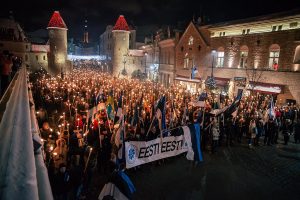 [Estonian far-right EKRE on the annual march through the Old Town of Tallinn, 2018, CC BY-SA 4.0]
[Estonian far-right EKRE on the annual march through the Old Town of Tallinn, 2018, CC BY-SA 4.0]
In the case of the Western Balkans, the gender issue is also often associated with the opposition to LGBTQI rights. Is this because these societies are still attached to old fashion stereotypes? Is the issue playing a central role in electoral campaigns?
To comprehend more adequately the wider implications of opposition to LGBTQI rights in Croatia, one needs to take into consideration the pact between Croatia’s Catholic clergy and the political establishment; as also stipulated in the so-called ‘Vatican Contract’. As part of this semi-formal arrangement, the governing HDZ granted its assent to the constitutional referendum on the same-sex marriage ban (1 December 2013) and still condones the Church’s opposition to sexual education. Throughout 2018, HDZ’s ‘right-wing faction’ concentrated on opposing ratification of the 2017 Istanbul Convention and its provisions for LGBTQI rights. Most recently, the Homeland Movement/DP defined marriage as ‘the union between a man and a woman, as stipulated by the Constitution’. The party also opposes allowing same-sex couples to adopt. HDZ backbenchers and the DP also allude to the external imposition of alien ethical norms on Croatian society. They are often calling for the EU to reform by returning to its original ‘European and Christian’ values.
In Serbia, according to certain theological and partly political narratives (e.g. the doctrine of Svetosavlje), Serbian national identity is to be understood not as a modern and individualistic notion but as a predominantly collectivist one. Along these lines, the Serbian nation is conceptualised in terms of an extended kinship, symbolically as well as literally. Therefore, any external influences that may potentially ‘disrupt’ this kinship, such as the EU’s guidelines on the rights of sexual minorities, are viewed through an inimical prism. Nevertheless, the steady cooperation between EU advisers and a sequence of Serbian governments, including those led by SNS, resulted in the establishment of an extensive legal infrastructure for the protection of minority rights, including LGBTQI rights. In all of this, Serbian media-NGOs have monitored the occasional propagation of allegations in domestic tabloids that the EU encourages the promotion of homosexuality (e.g. outlets such as Kurir and Srpski Telegraf). Nevertheless, this sociocultural aspect is side-lined by the paramount stress of Serbian Euroscepticism on geopolitics and foreign policy issues. One might argue that, by contrast to Croatia’s HDZ and its ‘right-wing faction’, gender-related issues do not form a significant component of the Eurosceptic narratives propagated by SNS-affiliates and the pro-government tabloids in Serbia.
However, in Serbia, Ana Brnabić, Prime Minister since 2017, is openly homosexual. Is this controversial with the country’s traditional morale? Did Brnabić’s politics promote LGBT legal reforms in the country?
This decision should be examined and comprehended inside the broader frame of SNS’ engagement into domestic and European politics. Especially the entrenchment of SNS as the preponderant political force has provided President Vučić with plenty of room for tactical and situationally adaptive manoeuvring. This has facilitated the Serbian President to placate a broad range of nationalistic/conservative interest groups in the interior (e.g. the historical restitution of controversial figures from the royalist Chetnik movement during the Second World War) while, simultaneously, extending symbolic gestures towards Brussels in regards to the Serbian government’s standard commitment to the EU system of values (e.g. the appointment of Ana Brnabić as PM in 2017). Overall, I judge that the improvement of the situation regarding LGBTQI rights in Serbia has mainly been the outcome of ‘EU persuasion’ and a long string of negotiations between Brussels and a series of Serbian governments since the early 2000s.
Vassilis Petsinis is Senior Research Fellow in Comparative Politics at the Johan Skytte Institute of Political Studies, University of Tartu, Estonia.

